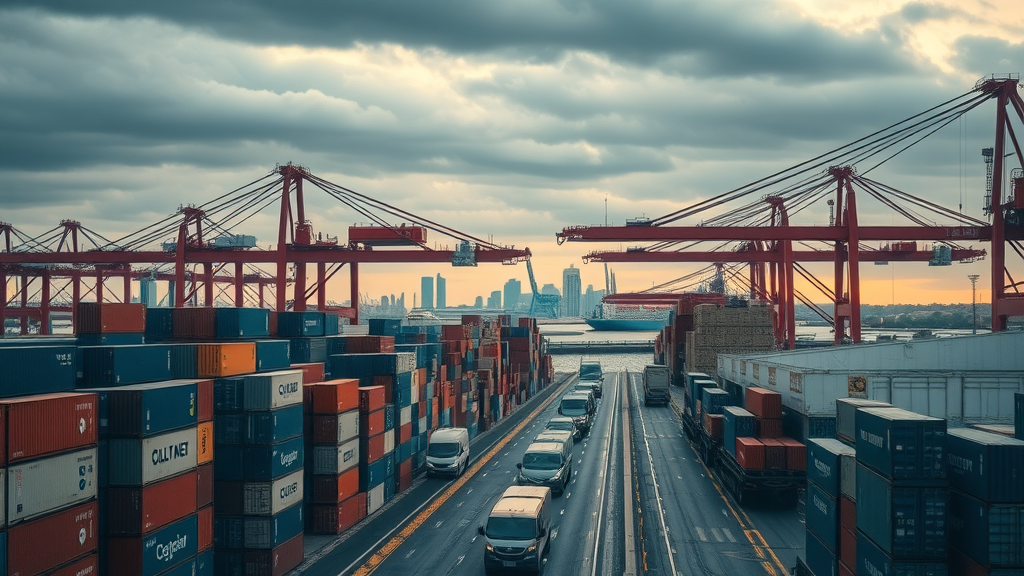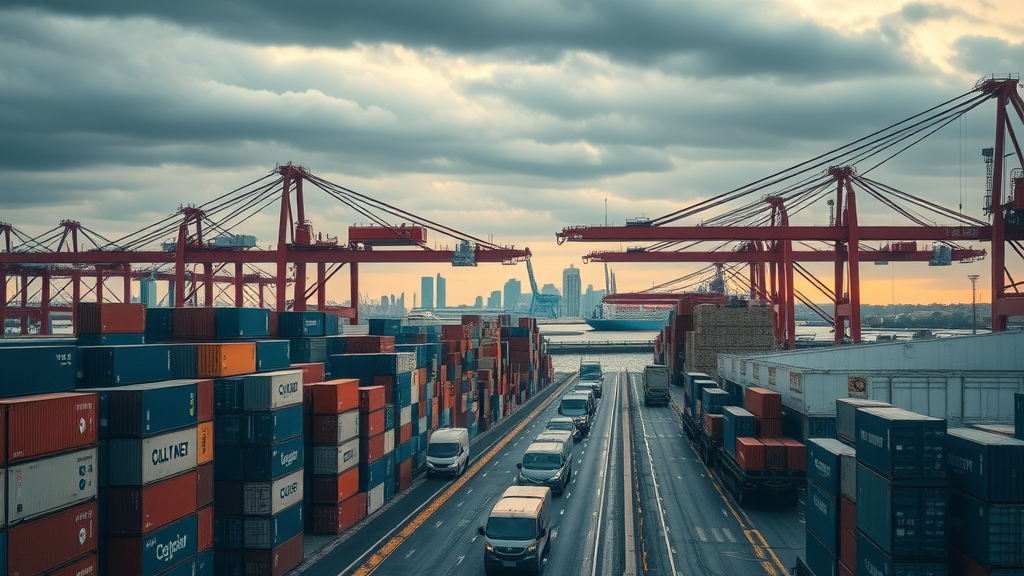Did you know that over $350 billion worth of imports are now subject to US tariffs? This dramatic shift disrupts not only global supply chains but also directly influences the prices you pay for groceries, electronics, and cars. As trade wars escalate, understanding what products are affected by US tariffs can help you prepare for rising costs—and make sense of the political debates dominating the news. Let’s dive into how these tariffs work, which sectors feel them most, and what the future might hold for consumers and industry. A Startling Trend: The Rapid Expansion of US Tariffs and Their Economic Repercussions Recent data shows that more than $350 billion worth of imported products face some type of US tariff, profoundly influencing global supply chains and consumer prices. Over the last several years, the United States has witnessed a rapid increase in tariff rates and new trade restrictions across a broad spectrum of products. The impact is far-reaching: global supply chains have been reconfigured, and American companies now grapple with higher costs for imported raw materials and finished goods . This phenomenon—often framed as a “trade war”—has led to a visible jump in consumer prices for many everyday items and has forced businesses to reconsider sourcing and production strategies. Tariffs are more than policy tools; they’re engines of price change that ripple through our economy. What’s most surprising is how quickly the trade landscape has changed. Just a decade ago, US tariff rates hovered near historic lows . Today, in part due to executive orders and policy shifts by leaders such as President Trump, tariffs and reciprocal tariffs are being wielded frequently and aggressively. This has left both US trading partners and American consumers exposed to new risks, including supply disruptions and price increases, particularly on agricultural goods, manufactured products, and electronics. The question is no longer whether tariffs affect your wallet, but how much . Understanding What Products Are Affected by US Tariffs: A Deep Dive into Policy and Price Defining US Tariffs: What Is a Tariff Rate and How Does It Work? A tariff is a tax placed on products imported into the United States, and the tariff rate determines the percentage increase in cost for those goods. The effective tariff rate is calculated based on the value of imported products and can vary significantly by product and trading partner. Effective tariff rates aim to protect domestic industries by making foreign goods more expensive, thereby encouraging consumers to "buy American." In practice, however, tariffs often mean a price hike for businesses and consumers alike. Sometimes, targeted tariffs—like those on steel, aluminum, or technology components—are used to send economic signals or retaliate against rivals in ongoing trade disputes. But tariffs are not an all-or-nothing proposition. Instead, they can be adjusted through trade deals, negotiations, and executive orders . When a higher rate is imposed under a specific trade policy, it can influence not just the targeted imports, but also raw materials used in domestic manufacturing. As a result, tariff policy is both a lever for international trade and an economic driver at home, affecting everyone from manufacturers to the end consumer. A change in tariff rates—even just a few percentage points—can have a ripple effect on retail prices, supply chain flexibility, and international competitiveness. How Effective Tariff Rates Shape International Markets When the United States increases its effective tariff rate , it sends shockwaves through international markets. Foreign companies may pass additional costs onto American buyers, reduce exports to the US, or find alternative markets. As the US raises its tariff rates, competition from international suppliers sometimes wanes, but costs for US manufacturers rise as imported raw materials—like steel or microchips—become more expensive. These price changes affect everything from the cost of cars to the expense of a new smartphone, and they often lead to a raise in consumer prices for end-users. Moreover, changes in effective tariff rates rarely go unanswered. US trading partners, notably the European Union, China, Canada, and Mexico, often respond with their own reciprocal tariffs on American exports. This back-and-forth shapes the current trade war dynamics, driving up costs for businesses that rely on exports and imports and creating headwinds for global growth. In this climate, tariff negotiations have become central to modern trade policy , determining the terms of access not just for big industrial players but for small businesses and even everyday shoppers. Reciprocal Tariffs, Trade Wars, and Global Competition When the United States levies tariffs on imports, trading partners frequently retaliate by imposing their own reciprocal tariffs . This response is at the heart of what is called a trade war . The escalation of tariffs between countries like the US and China has dramatically reshaped the international trading system, with each round of new tariff rates leading to higher prices, supply shortages, and uncertainty for consumers and businesses. Reciprocal tariffs are designed to offset the initial tax increase and pressure the original country to reconsider its trade policy. As each side raises tariffs, companies and consumers absorb the fallout—sometimes paying more for groceries, sometimes for cars, and often for technology products. The repercussions are rarely limited to imported goods; US exporters, from farmers to automakers, can lose access to lucrative markets. Tariff policy, once a quiet tool of diplomacy, has become a front-and-center issue for businesses and families alike . The Influence of President Trump and Recent Policy Shifts The Trump administration declared a new era in US tariff policy with a series of high-profile announcements and executive orders, fundamentally changing how the United States approaches global trade. President Trump announced tariffs on steel and aluminum in 2018, then followed up with sweeping tariffs targeting hundreds of billions of dollars’ worth of Chinese imports. These moves were meant to protect US jobs and challenge unfair trade practices, but they have also triggered a cycle of reciprocal tariffs by trading partners, notably China and the European Union. This shift toward higher tariff rates marked a departure from decades of relatively low average effective tariff rates . Suddenly, both American consumers and industries reliant on imports faced higher prices and supply chain disruptions . The consequences have been significant: certain sectors gained new protections, but most experienced higher costs, uncertainty, and a changed competitive landscape worldwide. The legacy of this period continues to influence tariff rates and trade negotiations today, often determining the fate of US companies in industries ranging from agriculture to advanced technology. Why an Average Effective Tariff Rate Matters to Everyday Consumers The average effective tariff rate refers to the total tariffs collected as a percentage of total imports, reflecting the real-world burden placed on imported products. When this rate climbs, so does the typical cost consumers pay at the checkout. While a few headline tariffs may catch attention, it’s often the cumulative effect that drives household budgets ever higher. For the average consumer, a higher effective tariff translates to gradually increasing prices on a wide spectrum of goods, from imported groceries and household appliances to high-tech gadgets. Even if you’re not buying an imported car or smartphone this year, you’re likely to feel the squeeze at the supermarket or electronics store. That’s why tracking the average effective tariff rate is essential for understanding the real impact of US trade policy—and why even small changes can ripple through every aspect of the economy and daily life. Which Products Are Most Impacted? A Sector-by-Sector Breakdown Using Effective Tariff Rate Data Agricultural Goods: What Groceries Will Be Affected by Tariffs? One of the most immediate and visible effects of new US tariff rates is found in the agricultural sector. Products like soybeans, pork, beef, dairy, seafood, and even some fruits and vegetables have seen price increases due to reciprocal tariffs imposed by trading partners, particularly China and the European Union. As the US targets foreign imports with tariffs, retaliatory measures often hit US agricultural exports—causing oversupply at home and depressed prices for farmers, while also leading to higher prices for imported goods on domestic shelves . For consumers, the impact is felt in the form of rising prices at the grocery store. Supermarket shoppers are now greeted with higher price tags on many essential staples, especially when trade wars escalate. Even products typically made in America can fluctuate in price, as global demand shifts and supply chain costs rise in response to new tariff rates. Shoppers are left navigating a more expensive and less predictable food market, making careful choices as tariffs ripple across the aisles. Manufactured Products: Autos, Electronics, and Appliance Vulnerability in the Trade War The trade war and shifting tariff rates have also taken a major toll on manufactured products such as automobiles, smartphones, and household appliances. US tariffs on autos and auto parts—especially those imported from the European Union, China, Mexico, and Canada—lead to higher sticker prices at dealerships and a more expensive buying experience for consumers. Even US-made cars are not immune; many contain foreign-made components subject to tariffs, so the costs eventually work their way back to domestic buyers. The story is similar in the world of electronics and home appliances. New tariffs on Chinese imports have raised costs for American retailers and limited choices for shoppers. From microwaves to smart TVs and laptops, higher tariff rates cause manufacturers to either absorb losses or pass price increases along to consumers. In some cases, companies have shifted production to other countries to avoid new tariffs, creating logistical headaches that can further raise prices and limit supply. Consumer Goods: How Higher Tariff Rates Raise Prices on Essentials Everyday items—think clothing, shoes, personal care products, and toys—are also impacted by increased tariff rates. As the United States imposes tariffs on textiles, footwear, and other household goods coming from major trading partners, retailers are forced to either raise prices or seek alternative suppliers at a higher cost . For families already watching their spending, these changes can make managing household budgets even more challenging. It’s not just about direct imports. Tariff rate changes up the supply chain can lead to incremental cost increases across a range of essentials. A toy assembled in Mexico might contain microchips from China or fabric from Vietnam—if any of these parts face US tariffs, the final price can go up. Over time, small increases pile up, creating a noticeable drag on consumer confidence and spending power. Raw Materials and Industrial Inputs: Steel, Aluminum, and the Ripple Effect Perhaps no sector has been more spotlighted during recent tariff debates than raw materials—specifically, steel and aluminum . President Trump’s decision to impose tariffs on these metals was justified on grounds of national security, aiming to revive US manufacturing and protect American jobs. These higher tariff rates, however, haven’t just affected foreign producers; US-based manufacturers that rely on imported steel or aluminum have seen their costs surge, making production more expensive and sometimes less competitive globally. The ripple effect extends throughout the economy. Suppliers that use steel and aluminum—such as automakers, appliance manufacturers, and construction firms—often pass on at least some of these costs to consumers. Retail prices for everything from canned goods to air conditioners have risen, evidence that even targeted tariffs can lead to a broader “tax increase” felt in many corners of the market. Major Product Categories Affected by US Tariffs, Corresponding Tariff Rates, and Potential Impact on Prices Product Category Typical Tariff Rate Potential Price Impact Agricultural Goods 10-25% Noticeable increases in supermarket prices (e.g., soy, pork, dairy) Manufactured Products 15-25% Higher costs for cars, appliances, electronics Consumer Essentials 10-20% Incremental cost hikes across clothing, toys, shoes Raw Materials (Steel/Aluminum) 10-30% Production cost increases for construction, autos, appliances Future Scenarios: Will the Current US Tariff Rate Strategy Persist or Shift? Analyzing Current Effective Tariff Rate Trends Across Sectors Effective tariff rates today are not uniform across sectors, and the average effective tariff rate in the US has risen noticeably since the onset of recent trade wars. Sectors like technology, automotive, and agriculture show the most pronounced changes, with companies facing ongoing uncertainty about the stability of trade policy. Many multinational corporations and small businesses report that even a few percentage points’ shift in effective tariffs can change where they manufacture products or source materials. While past decades brought frequent reductions in tariff rates under new trade deals, the trend has now reversed for many categories of imports. The varied and targeted nature of recent tariffs means that certain industries—like steel or tech—may see higher rates, while others, such as clothing or shoes, might experience fewer changes. This uneven landscape makes it difficult for businesses to plan for the future, as new negotiations and executive orders can suddenly shift the average effective tariff rate industry-wide. Forecasting the Potential for Escalation or Easing in Trade Wars As of 2024, economists remain split: Will the US continue on a path of higher tariff rates, or is a new era of trade diplomacy on the horizon? Some predict a cooling of the heated US-China trade war, with more reciprocal tariff negotiations leading to gradual reductions in rates and fewer market disruptions. Others warn that rising tensions—with China, the European Union, and other partners—could prompt further escalation. The outcome will hinge on political will, economic pressures, and the priorities of whichever administration holds power. One certainty is that consumer prices and business stability hang in the balance . Should tariffs continue to rise, more household goods and business inputs could see price increases, potentially slowing growth and raising inflation. Alternatively, a thaw in relations with key trading partners could bring relief in the form of lower tariffs, greater supply chain flexibility, and renewed investment in international trade. Reciprocal Tariff Negotiations with the European Union and Other Partners The United States and the European Union remain key trading partners, and the ongoing tug-of-war over tariff rates has fueled debates on both sides of the Atlantic. Reciprocal tariffs have affected high-profile sectors—think autos, chemicals, food products—and negotiations dictate the future flow of goods and jobs across borders. The EU, like other partners such as Canada and Mexico, often responds swiftly to US tariff hikes. These negotiations are complex and frequently influenced by other political events—ranging from domestic industry pressures to shifts in global alliances. As each side plays defense with its own effective tariff rate , the actions of policymakers have direct consequences for ordinary people, from factory workers to shoppers. The stakes are high: each trade deal can mean the difference between a price increase and price stability for millions of households and businesses. “Tariffs are like a hidden tax on consumers—a powerful tool, but a double-edged sword.” Opinion: Are Current US Tariff Policies Sustainable in a Globalized Economy? The Case for Strong Tariff Rates: National Security and Fairness Proponents of higher tariff rates argue that tariffs are crucial for protecting national security, American jobs, and a level global playing field. They point to industries like steel, semiconductors, and pharmaceuticals as vital to infrastructure and defense, asserting that tariff policy can insulate the US from supply chain risks and unfair foreign competition. In their view, targeted increases in effective tariff rates prompt foreign firms to operate by the same rules, leading to more balanced reciprocal tariffs and fairer trade overall. Supporters say that the average effective tariff rate should reflect national interests first—even if it means accepting higher prices in the short term. For them, a temporary tax increase on imports is an investment in domestic capacity, job creation, and technological leadership. History, they argue, shows that many core industries only survived foreign competition thanks to tariff protections at key moments. How Trade Wars Disrupt Business, Innovation, and Everyday Life On the other side, critics warn that persistent trade wars and escalating tariff rates can stifle innovation, drive up consumer prices, and worsen uncertainty for businesses large and small. Many US companies report that sudden tariff increases force them to delay investments, rethink product launches, or pay more for crucial materials like steel, rare earth metals, and microchips. Small businesses are particularly vulnerable, as they often lack the resources to shift suppliers or absorb price increases triggered by higher tariffs. Some have been forced to close, lay off staff, or abandon previously profitable ventures—collateral damage in a much larger fight over international trade policy. For everyday families, the legacy of a trade war is clearest in the cost of weekly groceries, gas, and goods at the mall . Personal Reflection: The Unintended Consequences for Small Businesses and Households Having covered the world of tariffs for years, I’ve heard countless stories from small business owners and families feeling the squeeze of trade wars. When tariffs lead to sharp price increases, it isn’t just big corporations that adapt—it’s the mom-and-pop stores, the farmers worried about their next harvest, and the families who suddenly find their grocery bill a little steeper each week. While the intention behind tariffs is often to promote fairness and protect jobs, the unintended consequences spill over into every corner of the economy . Higher costs, reduced supply options, and unpredictable policy shifts force Americans to adapt in real time. The debate over tariff rates isn’t abstract—it touches every dinner table and corner store. Should the US Pursue Reciprocal Tariffs or Seek Greater Collaboration? As debates continue, the critical question remains: Should the United States double down on reciprocal tariffs, or prioritize collaboration and strategic trade deals? While tough tariffs can send a message and protect certain sectors, long-term prosperity likely requires finding a middle ground. Coordinated solutions with trading partners often yield lasting economic stability, wider choices for consumers, and more resilient supply chains—key ingredients for thriving in today’s interconnected world. Whether through new trade deals, executive orders, or global forums, a thoughtful approach to tariffs and trade policy makes all the difference. Both sides of the political aisle can agree on one thing: the choices made in Washington reach every American household—and the world is watching . “Global trade isn’t just about numbers. It’s about people—their jobs, families, and futures.” Case Studies: How Tariff Rates and Trade Policies Transformed Key US Industries The Steel Industry’s Tariff Boost and Its Downstream Effects Following President Trump’s executive order imposing tariffs on imported steel, US steelmakers reported short-term growth in hiring and production. Protection from global competition made domestic steel more attractive—but manufacturers relying on steel, from auto companies to canned food producers, saw their own costs rise. In some cases, the price bump reached consumers in the form of more expensive goods or reduced product availability. Proponents call the move a win for national security; critics point to collateral damage throughout the wider economy. This industry’s experience shows how tariff policy changes—even when targeted—are felt far beyond the intended sector. As the average effective tariff rate on steel climbed, downstream businesses faced complex decisions, including whether to relocate operations, pass on higher rates to buyers, or absorb losses. Automobile Manufacturing: Navigating the Changing Landscape of Tariff Rates US automakers have had to adapt rapidly as tariff rates shifted under successive administrations. With the US targeting both imported vehicles and foreign-made parts, manufacturers that once relied on global supply chains confronted higher effective tariffs and an unpredictable regulatory environment. Some invested in domestic production; others sought trading partners with lower tariffs. Every decision introduced new costs and risks, making long-term planning difficult. For the average American, these changes meant higher sticker prices and fewer choices at the dealership . Some firms have managed to innovate their way out of trouble, but the sector as a whole is now shaped as much by executive orders and trade talks as by customer demand or product development. Agricultural Exports: Reciprocal Tariffs and the Rise of New Trade Barriers Farmers across the US have experienced the sharp end of the reciprocal tariff stick. When the United States imposed sweeping tariffs on Chinese goods, China quickly retaliated by hitting American soybeans, pork, and other crops with high tariff rates. This left farmers struggling with lost export markets, falling prices, and a glut of unsold goods back home. While some subsidies provided short-term relief, the long-term uncertainty over trade policy has forced many to rethink which crops to plant, where to sell, and how to stay afloat. The story is similar with the European Union and North American trading partners. Every adjustment to the average effective tariff rate has a domino effect—reinforcing the reality that food security, farm incomes, and rural economies all hang in the balance. Tech Products and the Unfolding US-China Trade War The US-China trade war highlighted just how interconnected—and vulnerable—the tech sector is to changes in tariff policy. Tariffs on semiconductors, smartphones, and computer parts have forced American companies to rethink their manufacturing strategies and global partnerships. Higher effective tariff rates raise costs and threaten the pace of innovation, while reciprocal tariffs from China limit US access to crucial supply chains and markets. This standoff has had a palpable impact on consumer prices for electronics. Shoppers now face price increases on everything from laptops to routers, while companies navigate tangled webs of new regulatory requirements and international trade barriers. As technology continues to reshape the economy, the consequences of tariff policy in this area will echo for years to come. In Focus: What Products Does the US Have Tariffs On? Overview of Product Categories Currently Facing Tariff Rates The list of products subject to US tariffs continues to grow, especially as new trade policies target industries with global supply chains or areas identified as key to national security. Major categories include agricultural goods (soybeans, beef, pork, dairy, seafood), manufactured items (automobiles, appliances, electronics), and raw materials (steel, aluminum) . Tariffs on advanced technology products, clothing, and even some household goods have also been implemented or expanded in recent years. The result is a patchwork of tariff rates by product and partner country. As trade negotiations evolve, new categories may be added or removed. For now, most consumers encounter tariffs’ impact in the form of higher prices on imported goods, while domestic industries adjust to fresh competitive pressures—or, in some cases, opportunities. Essential Facts About Which Industries Are Most Affected by Tariffs Certain industries bear the brunt of tariff policy more than others. Farming and agriculture, automaking, electronics, and steel production face the highest and most frequently shifting rates. The effective tariff rate in these sectors often exceeds the national average, translating into more direct impacts on business costs, employment levels, and consumer prices. Other sectors—such as construction, energy, and home goods—may experience more indirect effects, feeling the strain as suppliers and partners pass on increased costs. The result is a ripple effect that touches both direct producers and a much wider network of businesses and workers. “The average effective tariff rate in 2023 is the highest it’s been in decades—a significant shift from previous US policy.” Breaking Down the Three Main Effects of Tariffs on Products and Consumers Raise Prices for Consumers Tariffs often act as a hidden tax increase, driving up the price of imported goods and essentials like food, clothing, and electronics. Businesses may try to absorb some of these costs, but the majority is usually passed on to shoppers, leading to a general rise in consumer prices. Reduce Supply Chain Flexibility Higher or unpredictable tariff rates disrupt established supply chains, forcing companies to seek new suppliers or reshuffle production networks. This can cause delays, shortages, or lower quality as businesses try to minimize the impact of tariffs on their bottom line. Prompt Retaliatory Reciprocal Tariffs When the US increases tariffs, trading partners frequently respond in kind, targeting American exports. This cycle of reciprocal tariffs can close off foreign markets for domestic producers, harm export sales, and contribute to the ongoing global trade war. Real-World Examples: How Tariff Rate Increases Impact the Everyday Shopper Consider the cost of a weekly grocery trip. When reciprocal tariffs hit soybeans and pork, American farmers lost export markets and domestic prices fell briefly, but supermarket prices for related goods—including dairy, seafood, and processed foods—rose due to supply imbalances and higher production costs. Meanwhile, tariffs on imported electronics translated directly into higher price tags for smartphones and laptops at big-box retailers. Shoppers looking for a new car or major appliance saw average sticker prices rise as tariffs increased the cost of both finished imports and parts used in domestic manufacturing. Over time, even modest increases in effective tariff rates can take a significant bite out of household budgets. Key Insights: Average Effective Tariff Rate Compared to Historical Norms Has the US Effective Tariff Rate Reached a Historic High? Recent years have brought the highest average effective tariff rate seen in decades. Following an era of declining tariffs and expanded trade deals, the United States has sharply reversed course, particularly since 2018. This historic increase is felt across nearly every sector, with some industries seeing their effective tariff rates double or more. Economists warn that, unless policy shifts, these elevated rates are likely to persist—potentially raising consumer prices and reshaping international trade relationships for years to come. Lessons from the European Union’s Tariff Strategies The European Union, a key US trading partner, has long deployed a sophisticated tariff strategy balancing protection for domestic industries with participation in global trade. In some sectors, EU tariff rates are higher than those in the US; in others, lower. The EU’s approach offers a practical template for how the US might manage reciprocal tariffs and sector-specific adjustments without triggering runaway price increases or major trade wars. Collaborative negotiation and smart regulation have allowed the EU to navigate global shocks while maintaining relatively stable consumer prices—something US policymakers may look to as they rebalance their own approach to tariffs and trade policy. International Comparison: How the US Stacks Up on Reciprocal Tariffs On the global stage, the US is not alone in the use of tariffs to shape trade relationships. Major economies such as China, Canada, Mexico, and the European Union maintain their own tariff regimes—often striking back with reciprocal tariffs when US rates rise. While the average effective tariff rate varies widely by country, the recent uptrend in US rates has made the country’s stance more protectionist than at any point in recent memory. The chart below illustrates how the United States compares with key trading partners in terms of the average effective tariff rate as of 2023. Table: Average Effective Tariff Rate by Country (2023) Country Average Effective Tariff Rate United States 4.2% European Union 3.1% China 5.8% Canada 2.5% Mexico 2.0% Listing the Groceries and Products Most Directly Impacted by US Tariffs Soybeans Beef Pork Seafood Dairy products Household electronics Automobiles Steel and aluminum products People Also Ask What products does the US have tariffs on? The United States maintains tariffs on a wide range of products including agricultural items (soybeans, pork, dairy, seafood), manufactured goods (automobiles, electronics, appliances), and raw materials (steel, aluminum). These tariffs can target entire sectors or specific product categories based on trade policy decisions or ongoing negotiations. The list shifts frequently as trade talks progress with countries like China, the European Union, Canada, and Mexico. Comprehensive listing and commentary on affected product categories including agricultural, manufactured, and technology goods. Products most commonly affected by US tariffs include agricultural staples like soybeans, beef, pork, and dairy; manufactured products such as automobiles, microwaves, and air conditioners; technology goods like smartphones and computer parts; and essential raw materials including steel and aluminum. Retailers, manufacturers, and farmers all feel the pressure of these policy shifts, and most Americans encounter their effects in the form of higher prices at the store. What industries are most affected by tariffs? Industries most impacted by tariffs include agriculture, automotive manufacturing, technology, and steel. These sectors regularly face the highest and most unpredictable tariff rates, often seeing costs rise for both imported materials and exported goods. Downstream effects are felt across construction, retail, and food industries as supply chains adjust and businesses pass along increased costs to consumers. Analysis of which sectors bear the brunt—from manufacturing and farming to tech and retail. The sectors bearing the greatest burden of tariffs include manufacturers (especially autos and appliances), farming and agriculture, tech companies, and industries using large amounts of imported raw materials. Small businesses within these sectors face high risks, while entire regional economies can be disrupted by sudden changes in tariff rates or new reciprocal tariff regimes. What groceries will be affected by tariffs? Groceries most affected by tariffs include soybean products, beef, pork, dairy, seafood, and processed foods with imported ingredients. As reciprocal tariffs and new trade policies are enforced, prices for these staples often rise, sometimes rapidly, leaving consumers with fewer affordable options at the supermarket. Details on produce, proteins, and imported staples at risk of price hikes. Produce, proteins, and staple foods such as fresh and frozen meats, dairy items, seafood, and even some fruits and vegetables face tariff-driven price hikes. Imported grains and cooking oils, processed snacks, and beverages can also become more expensive, as retailers adjust prices to account for new tariff rates and increased sourcing costs. What are the three main effects of tariffs? The three main effects of tariffs are: higher consumer prices for imported and some domestic goods; reduced supply chain flexibility for businesses, making it harder and more costly to obtain products or parts; and retaliation by trading partners in the form of reciprocal tariffs, which can disrupt US export sales and escalate global trade tensions. Summary and examples showing impact on prices, trade relationships, and product availability. Tariffs raise the price of goods (such as groceries and electronics), strain trade relationships by sparking cycles of retaliation, and can limit the availability or increase the cost of both imported and domestic products. Real-world examples include rising costs for steel-based products, higher grocery bills, and disrupted smartphone deliveries due to supply chain issues. Frequently Asked Questions About What Products Are Affected by US Tariffs Do tariffs benefit or harm the US economy? Tariffs can offer short-term protection to specific industries and may support national security goals. However, they often raise consumer prices and disrupt business planning, so the long-term effects on the overall economy are debated among experts. Will tariff rates continue to increase? Tariff rates could continue to rise if trade wars escalate, but future trends will depend on the outcome of current international negotiations and political shifts in Washington. Some hope for a return to lower rates and greater trade cooperation. Are there exemptions to certain US tariffs? Yes, some products and trading partners receive exemptions or lower rates based on trade deals, national security considerations, or special negotiations. However, most affected products remain subject to the published tariff rates unless official changes are announced. How do reciprocal tariffs play into trade deals? Reciprocal tariffs are used by trading partners to respond to US tariffs, often targeting American exports in politically sensitive industries. These tit-for-tat measures can complicate trade deal negotiations and increase costs for businesses on both sides of the border. Essential Facts: What You Need to Know About What Products Are Affected by US Tariffs Tariffs impact both imported goods and the domestic industries reliant on them. The average effective tariff rate is subject to policy shifts and trade negotiations. Trade wars and reciprocal tariffs can spark unpredictable changes in supply and cost. Got an Opinion on What Products Are Affected by US Tariffs? Make Your Voice Heard Got Something to Say About Global Trade? RP Design Web Services can put your insights on Global Trade Notes in front of the right audience. Call 203-271-7991 today and get your word out. Actionable Next Steps: Stay informed about changing tariff rates, compare prices before major purchases, and let policymakers know how tariffs affect your business or household. Don’t let unexpected price hikes catch you off guard—knowledge is your best tool. Recent U.S. tariff policies have significantly impacted a wide range of imported products, leading to higher prices for consumers and challenges for various industries. For instance, a 50% tariff on Brazilian orange juice byproducts is expected to cause substantial economic losses for Brazilian exporters and disrupt the U.S. market for reconstituted juice. ( reuters.com ) Additionally, tariffs on consumer electronics, automobiles, and agricultural goods have led to price increases and supply chain adjustments. ( usimportdata.com ) Understanding these developments is crucial for consumers and businesses navigating the evolving trade landscape.






 Add Row
Add Row  Add
Add 




Write A Comment